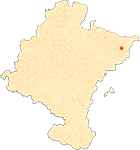Route through the Roncal altarpieces
By Ricardo Fernández Gracia
Altarpiece of the Shrine of Our Lady of Fair Love of Our Lady of Idoia
Presiding over the sanctuary, at the back of its sober 16th century stone nave and behind a grille that tradition says comes from the monastery of Igal, is a beautiful Solomonic altarpiece in whose main niche is the Gothic image of Our Lady of Idoia, of great devotion in the town and in the Valley.
According to datapublished by Fernando Hualde, the person who provided the means to do so was Vicente Ros, a native of Isaba and resident in Seville, who acted as a benefactor in his native town, covering some of the costs of repairing the Shrine of Our Lady of Fair Loveof Idoia, as well as the construction of a chapel dedicated to San Francisco Javier. In the register of ships that sailed to Veracruz at filede Indias (AGI/10.13.8.429//Contratación,1483), in 1695, one is registered with degree scrollof "Jesús Nazareno, Nuestra Señora del Pópulo y San José" with azogues and with our character, Vicente Ros, as the ship's master. This is the only case of an altarpiece paid for with funds from an Indiano in the Roncal Valley.
The altarpiece has been linked to the work of Juan Baines, author of the main altarpiece in Garde (1699-1701) and a native of Garde, and even to the workshops in Tudela. We have been able to corroborate the latter hypothesis with the findingof the contract deed, signed on 17 July 1694 (AGN. Protocolos Notariales. Roncal. Miguel Baines, 1694). His datais conclusive in stating that it was done in the name of Vicente Ros, established in Cádiz and originally from Isaba, on whose behalf some clergymen from Isaba and Vicente's father acted. The master who carried it out was Francisco San Juan y Velasco, from the Tudela workshop and father of José de San Juan, author of the altarpieces of Cárcar and Miranda de Arga. The modelindicated was the main altarpiece of the Jesuits in Pamplona, which the aforementioned master had just completed, a work that has not been preserved. The wood was to be supplied by position, the artist was to reside in Isaba for the duration of the work and the agreed price was to be 618 ducats.
The piece covers the entire chevet of the church and consists of a bench with two exterior netting and two interior corbels, a body divided into three sections and articulated by salomonic elements dressed with dynamic plant motifs and children's heads, and an attic with stipes. The main feature is the decoration that dresses all its Structureswith fine, rich foliage that incorporates children's heads, angels and a kind of mixed fish and human beings, like mermaids that appear in other Navarrese altarpieces such as the aforementioned one in Cárcar. The iconography of the altarpiece is reduced to the main figure flanked by the sculptures of San Joaquín and San Vicente and another saint who has been identified as San Cipriano in the attic, although the contract indicates that it is San Gregorio Ostiense.
Parish archives of Garde, Vidángoz, Isaba, Uztárroz and Roncal.
file Diocesan of Pamplona. Processes
file General of Navarre. Roncal Notary's Office and Processes
ARDANAZ IÑARGA, N., La catedral de Pamplona en el siglo de las Luces. Arte, ceremonial y cultura, Pamplona, doctoral dissertation sustained at the University of Navarre, 2011. Vid. http://hdl.handle.net/10171/20480
BOLOQUI LARRAYA, B., Escultura zaragozana en la época de los Ramírez 1710-1780, Madrid, Ministerio de Cultura, 1983.
CHOCARRO HUESA, M., "El obispo Juan Rena, mediador y mecenas artístico de la catedral de Pamplona", Príncipe de Viana, 256 (2012), Issue dedicated to: programs of study sobre el Patrimonio Cultural y las artes en Navarra en torno a tres hitos 1212-1512-1812, (coordinated by Ricardo Fernández Gracia), pp. 587-601.
CLAVERÍA ARANGUA, J., Iconografía y santuarios de la Virgen en Navarra, vol. I, Madrid, Gráfica management assistant, 1942.
ECHEVERRÍA GOÑI, P., Polychromy of the Renaissance in Navarre, Pamplona, Government of Navarre, 1990.
GARCÍA GAÍNZA, M. C., Romanesque sculpture in Navarre. Disciples and followers of Juan de Anchieta, Pamplona, 1969.
GARCÍA GAÍNZA, M. C. et alt., Catalog Monumental de Navarra, IV* y IV**. Merindad de Sangüesa, Pamplona, Government of Navarra - Archbishopric of Pamplona - University of Navarra, 1989 and 1992.
FERNÁNDEZ GRACIA, R., El retablo barroco en Navarra, Pamplona, Government of Navarre, 2003.
FERNÁNDEZ GRACIA, R., "Los géneros escultóricos", El arte del Barroco en Navarra, (coord. R. Fernández Gracia), Pamplona, Gobierno de Navarra, 2014, pp. 175-271.
GÁRRIZ, J., La villa de Garde en el Valle del Roncal. essay de una monografía parroquial, Pamplona, Casa publishing house de G. Huarte, 1923.
HUALDE, F., "De cuando los Ezquer cruzaron el charco", Diario de Noticias de Navarra, 18 August 2008. http://patrimonionavarra2.blogspot.com.es/2010/09/18-de-agosto-de-2008.html
MORALES SOLCHAGA, E., "El gremio de San José y Santo Tomás de Pamplona hasta el siglo XVII", Príncipe de Viana, no. 239 (2006), pp. 791-860.
URANGA, J. E., Retablos navarros del Renacimiento, Pamplona, Institución Príncipe de Viana, 1947.












